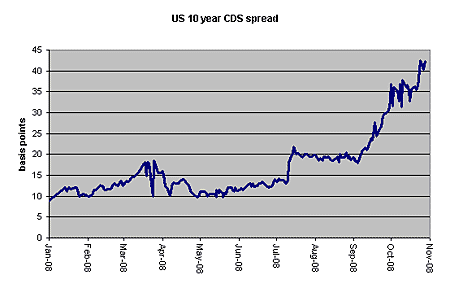It looks increasingly likely that the endgame in the credit crisis will be a bloody stand-off between investors and governments. Their battlefield will be the market for government bonds, where countries all around the world finance their deficits.
To see how this is likely to come about, it helps to revisit the various stages of the credit crunch. It began in 2007 with the drying-up of liquidity in esoteric, structured-finance securities, linked to riskier types of mortgages. From there it spread to more mainstream mortgage bonds, structured finance in general, and other types of debt issued by financial institutions. By early summer 2008 the crisis was affecting many non-financial corporate names, who found difficulties refinancing loans. By the end of the summer the crisis had spread to sovereign names a whole host of governments found themselves in trouble. So far the most acute problems have arisen in countries with high current account deficits Ukraine, Hungary and in Iceland, where financial sector problems threaten to overwhelm state finances.
But just as tingling and numbness in the extremities of the body can give advance warning of a heart attack, the way credit market problems have developed from specialist subsectors to ever more mainstream areas - is giving us clear warning that the crisis may be heading for the very centre of the global finance system, the major economies' bond markets.
MoneyWeek
Subscribe to MoneyWeek today and get your first six magazine issues absolutely FREE

Sign up to Money Morning
Don't miss the latest investment and personal finances news, market analysis, plus money-saving tips with our free twice-daily newsletter
Don't miss the latest investment and personal finances news, market analysis, plus money-saving tips with our free twice-daily newsletter
Any textbook on finance and investing will introduce early on the concept of a risk-free rate of return, and then use it as the basis for many financial ratios and analyses. For the risk-free rate, analysts have traditionally used the yield on a short-maturity government bond. The excess returns on other financial instruments are then interpreted as risk premia over the government bond (which is considered free of default risk). Historically this led to a comfortable stratification of debt securities, with higher-risk, lower-rated bonds layered on top of other, safer ones. Built on a bottom stratum of AAA-rated US treasuries, yield spreads increased steadily through each layer, to reach the riskiest, junk issues on top.
The idea of a stable layering of risk premia, based on credit agency ratings, has been thrown into disarray over the last year, as the ratings themselves proved to be completely unreliable. Yet in recent months something disturbing has started to go wrong with the groundrock itself the major government bond markets. The tectonic plates underlying the whole superstructure of debt have started to shift.
On the surface nothing remarkable is happening the 30 year US Treasury bond yield recently hit an all-time low of 3.88%, as investors sought a safe haven during equity market turbulence. Yet while nominal bond yields have declined, the credit risk component of US Treasuries has been on an increasing trend since last year. According to data provided by CMA DataVision, the credit specialists, the 10-year credit default swap spread a form of insurance contract against issuer default has risen steadily - from 1.6 basis points (0.016%) in July 2007, to 16 basis points in March 2008, to 30 basis points in September, to over 40 basis points on October 27 see the chart below for the spread history so far this year. In other words the cost of insuring against a US government default has risen by 25 times in little over a year. Similar trends have been evident in the UK and German government bond markets.

This has perplexed, and even amused, some market observers. How, they ask, could a private sector contract against default be expected to pay out in the case of a US government default which would be the equivalent of a nuclear explosion in the financial markets? So what's the point of buying such a contract?
Moreover, how could the US government ever renege on its debts? After all, it supplies the world's reserve currency, and the Federal Reserve Chairman reminded us a few years ago of the US authorities' ability to print money in unlimited quantities. Any "default" would at least be through the time-tested mechanism of inflation and currency devaluation, according to this view.
On the other hand a longer-term examination of debt markets reminds us that, throughout human history, regular default is more the rule than the exception. And while sovereign defaults on external, foreign-currency debt are most common, Carmen Reinhart and Kenneth Rogoff demonstrated in a paper released earlier this year [pdf download] that defaults on domestic debt have happened far more often than might have been expected, particularly in times of severe economic duress.
In both the US and UK, budget deficits are poised to explode, for a number of reasons. The recession is hitting tax revenues, while government entitlement programmes should soar in cost. Then there is the steadily increasing bill for the wars being fought in Iraq and Afghanistan. But the really big impact is coming from the rescue packages being thrown at the financial sector. Morgan Stanley recently estimated that the 2009 fiscal deficit in the US would reach 12.5%, over double the previous record of 6%, set in 1983. Under the Bush administration, the US national debt has risen from $5.7 trillion, to over $10 trillion currently. The terms of the recently-passed bailout legislation increased the statutory debt ceiling to over $11.3 trillion.
When measured as a percentage of GDP, the US national debt is expected to pass 70% next year, which, though much higher than recent years, is still short of the record 122% registered in 1946, at the end of the Second World War. Some observers point to this comparison as an argument for the sustainability of the current position.
Yet others argue that government debt must be seen in the context of, and as part of, the overall debt burden on the economy. With the US private debt to GDP ratio at levels never seen before close to 300%, according to Steve Keen, the Australian economist the question is surely whether the whole debt pyramid can avoid crashing down via a violent and uncontrollable chain of defaults, dragging the government bond market down with it. If this seems far-fetched, it helps to remember that the Latin root of the word credit comes from credere to believe, but also to trust. For large sections of the private sector bond market, it is precisely that trust which has disappeared over the last year and a half. To suggest that such "credit revulsion", to use an old term, might spread to governments' debt obligations is surely not beyond the realms of possibility.
Signs of strain in the US Treasury market are already there, despite the current low yields. Recent auctions have shown poor bid-to-cover ratios, and long tails (the difference between the average accepted yield, and highest yield), both signs of shallow demand. Delivery failures in the secondary market have also hit record levels, a sign of poor liquidity. Market observers should keep a close eye on the progress of future auctions, particularly as the issuance schedule picks up.
How can investors take cover if concerns over government solvency spread? For the early part of any credit-related decline in bond prices, there are obvious hedges, such as credit default swaps, short Treasury bond futures positions and inverse Treasury ETFs. But ultimately a US debt default would have cataclysmic consequences for the financial economy, bankrupting the entire system. So the ultimate safe haven is in the precious metals, which would rapidly regain monetary status in such a scenario.
This article was written by Paul Amery, European Editor of www.indexuniverse.com
Get the latest financial news, insights and expert analysis from our award-winning MoneyWeek team, to help you understand what really matters when it comes to your finances.
MoneyWeek is written by a team of experienced and award-winning journalists, plus expert columnists. As well as daily digital news and features, MoneyWeek also publishes a weekly magazine, covering investing and personal finance. From share tips, pensions, gold to practical investment tips - we provide a round-up to help you make money and keep it.
-
 How to protect property in a divorce – and the common mistakes to avoid
How to protect property in a divorce – and the common mistakes to avoidThe festive period can sadly push some marriages to breaking point, forcing couples to consider what will happen to their property after divorce.
-
 Why you fear money – and how to fix it: MoneyWeek Talks
Why you fear money – and how to fix it: MoneyWeek TalksPodcast MoneyWeek's digital editor, Kalpana Fitzpatrick, speaks to financial psychotherapist Vicky Reynal about how to change your money mindset for the better.

